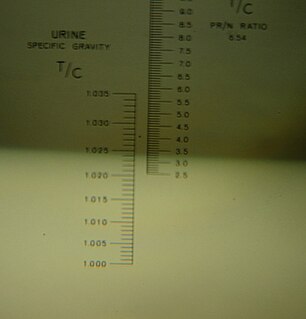 W
WClinical urine tests are examinations of the physical and chemical properties of urine and its microscopic appearance to aid in medical diagnosis. The term urinalysis—a blend of the words urine and analysis—generally refers to the gross (macroscopic) examination of the urine, chemical evaluation using urine test strips, and microscopic examination. Macroscopic examination targets parameters that can be measured with the naked eye, including volume, color, transparency, odor, and specific gravity; urine test strips measure chemical properties such as pH, glucose concentration, and protein levels; and light microscopy is performed to identify elements such as cells, urinary casts, crystals, and organisms. Other analyses routinely performed on urine samples include urine electrolyte levels, drug testing, pregnancy testing and microbiological culture.
 W
WBence Jones protein is a monoclonal globulin protein or immunoglobulin light chain found in the urine, with a molecular weight of 22–24 kDa. Detection of Bence Jones protein may be suggestive of multiple myeloma or Waldenström's macroglobulinemia.
 W
WUrine organic acids is a medical diagnostic test that measures organic acid metabolites in the urine. The metabolites can come from host cells or from flora. The test can be used to exclude the possibility that a person has an inborn error of metabolism, usually one of the organic acidemias. It is also used to look for problems with nutrition or evidence of certain infections or bacterial overgrowth. The usual method of analysis is tandem mass spectrometry.
 W
WSpecific gravity, in the context of clinical pathology, is a urinalysis parameter commonly used in the evaluation of kidney function and can aid in the diagnosis of various renal diseases.
 W
WA urine test strip or dipstick is a basic diagnostic tool used to determine pathological changes in a patient's urine in standard urinalysis.
 W
WUrodynamic testing or urodynamics is a study that assesses how the bladder and urethra are performing their job of storing and releasing urine. Urodynamic tests can help explain symptoms such as:incontinence frequent urination sudden, strong urges to urinate but nothing comes out problems starting a urine stream painful urination problems emptying the bladder completely recurrent urinary tract infections
 W
WUroscopy is the historical medical practice of visually examining a patient's urine for pus, blood, or other symptoms of disease.